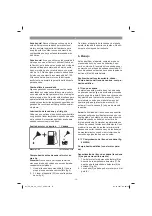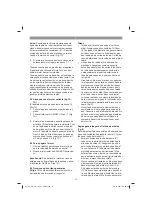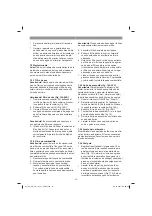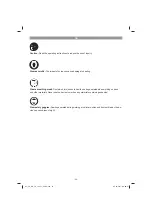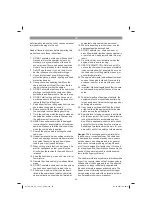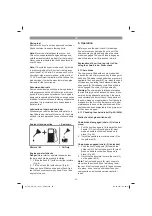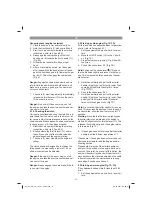
GB
- 27 -
Should you observe any unusual impairments,
interrupt your work immediately and consult a
doctor.
Follow these instructions in order to reduce the
dangers:
•
Keep your body and in particular your hands
warm when working in the cold
•
Take regular breaks and move your hands
to stimulate the blood circulation during the
breaks.
•
Ensure that the equipment makes the least
possible vibration through regular mainte-
nance and solid parts on the equipment.
Kickback may occur when the nose or tip of the
guide bar touches an object, or when the wood
closes in and pinches the saw chain in the cut.
If the bar tip contacts, it may cause a lightning-
fast reverse reaction, kicking the guide bar up
and back towards the operator. Pinching the saw
chain along the top of the guide bar may push
the guide bar rapidly back towards the operator.
Either of these reactions may cause you to lose
control of the saw, which could result in serious
personal injury. Do not rely exclusively upon the
safety devices built into your saw. As a chain saw
user, you should take several steps to keep your
cutting jobs free from accident or injury.
1. With a basic understanding of kickback, you
can reduce or eliminate the element of surpri-
se. Sudden surprise contributes to accidents.
2. Keep a good
fi
rm grip on the saw with both
hands, the right hand on the rear handle, and
the left hand on the front handle, when the
engine is running. Use a
fi
rm grip with thumbs
and
fi
ngers encircling the chain saw handles.
A
fi
rm grip will help you reduce kickback and
maintain control of the saw. Don’t let go.
3. Make sure that the area in which you are
cutting is free from obstructions. Do not let the
nose of the guide bar contact a log, branch,
or any other obstruction which could be hit
while you are operating the saw.
4. Cut at high engine speeds.
5. Do not overreach or cut above shoulder
height.
6. Follow manufacturer’s sharpening and main-
tenance instructions for the saw chain.
7. Only use replacement bars and chains speci-
fi
ed by the manufacturer or the equivalent.
8. If the equipment becomes jammed when
cutting, switch it o
ff
immediately and free it
carefully. Finally, check the equipment for da-
mage (e.g. a bent chain bar) and carry out a
test run.
2. Layout and items supplied
2.1 Layout (Fig. 1-21)
1. Motor unit
2. Chain
bar
3. Saw
chain
4. Chain
guard
5. Spark plug wrench
6. Front hand guard (chain brake lever)
7. Front
handle
8. Rear
handle
9. Starter
handle
10. On/O
ff
switch
11. Throttle lever
12. Throttle lever safety lock
13. Choke lever
14. Air
fi
lter cover
15. Air
fi
lter
16. Spark plug
17. Stop claw
18. Chain catch
19. Chain bar fastening nut
20. Chain tensioning screw
21. Fuel tank cap
22. Oil tank cap
23. Mixing container
24. Screwdriver
25. Fuel pump (primer)
Safety features (
fi
g.1a/1b)
3
LOW KICKBACK SAW CHAIN helps signi-
fi
cantly reduce kickback, or the intensity of
kickback, due to specially designed depth
gauges and guard links.
6
CHAIN BRAKE LEVER / HAND GUARD
protects the operator’s left hand in the event it
slips o
ff
the front handle while saw is running.
CHAIN BRAKE is a safety feature designed
to reduce the possibility of injury due to
kickback by stopping a moving saw chain
in milliseconds. It is activated by the CHAIN
BRAKE lever.
10
STOP SWITCH immediately stops the engine
when tripped. Stop switch must be pushed to
ON position to start or restart engine.
12
SAFETY TRIGGER prevents accidental
acceleration of the engine. Throttle trigger
cannot be squeezed unless the safety latch is
depressed.
18
CHAIN CATCHER reduces the danger of
injury in the event saw chain breaks or derails
during operation. The chain catcher is desig-
ned to intercept a whipping chain.
Anl_SA_GC_PC_1235_1_SPK8.indb 27
Anl_SA_GC_PC_1235_1_SPK8.indb 27
05.01.2017 09:06:47
05.01.2017 09:06:47



